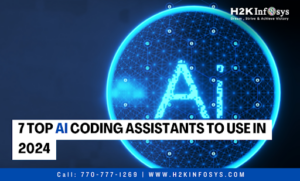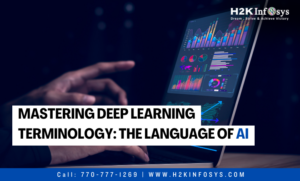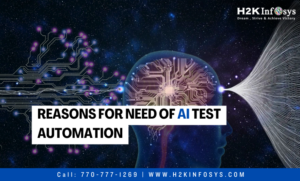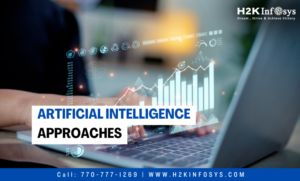The application of artificial intelligence now spans multiple diverse industries and fields of life. Artificial intelligence continually revolutionizes the way we live and do things, including work and business activities. For you to become well-grounded in the field of AI, you’ll have to undergo proper training by an expert in the field; for instance, you can quickly sign up for an artificial intelligence online training and learn from the comfort of your home.
In particular, the health industry has received a significant boost on applying artificial intelligence and machine learning in solving several health-related problems; this is large since AI majorly deals with datasets. Here we are talking about vast amounts of data of various individuals collected and utilized in developing and training machines to perform health functions such as Diagnosis of diseases, treatment, drug prescription, scanning, etc. The prevalent coronavirus pandemic (COVID-19) has served as a significant setback to many countries and businesses. The pandemic’s ravaging effects are heavily felt in all industries/sectors of the economy, including health care, banking, government, insurance, retail, and production.
The coronavirus pandemic reminds us of several viral disease outbreaks that the world has had to deal with in the past, such as Bird flu, Ebola, Chikungunya, MERS, and SARS. However, the novel COVID-19 disease outbreak hit the world harder and caused more damage to human health and a higher death rate than the previous outbreaks the world has ever experienced. Due to the high speed of spreading the virus and its deadly nature, the COVID-19 pandemic has transformed the world system. There have been recent changes in the way we relate with one another as human beings. Employees and staff now work from home; companies now conduct virtual meetings with management staff. Human resource management currently conducts virtual interviews. Students and pupils are now forced to learn from home via various online learning platforms such as zoom, Microsoft teams, google meet, EZ talks, and meetly. You and I are now mandated to put on face masks as part of our regular dressing wherever we go. All these new patterns of lifestyle came about as a result of the atypical COVID-19 pandemic. Also, this has raised several questions about how we can effectively cope with this crisis. The high rate at which the virus amplified caused several governments, businesses, and customers to look for answers to the problem desperately. Researchers began channeling their resources and full attention towards studying and understanding the virus and how it spreads, plus how the spreading can be curtailed. So how are we able to deal with this virus? One may ask.
Artificial intelligence has played an immense role in the management and curbing of the COVID-19 pandemic. Over a year and a few months now, we have witnessed huge applications of Artificial intelligence, machine learning, and deep learning in addressing the COVID-19 pandemic. As a result, there has been a recent surge in the number of sign-ups for artificial intelligence online training as well as AI certification training courses. In this tutorial, we would be discussing various roles that artificial intelligence has played in tackling the coronavirus pandemic.
The roles of AI in tackling the COVID-19 pandemic
1. Reducing the spread of the virus
Top AI development companies have been collaborating with the healthcare industry to explore creative solutions that could be adopted to slow down the transmission of the virus from person to person, provide effective treatment, and protect the public from the virus. According to reports released by the world health organization in February 2020, AI played a vital role in the initial response that china applied to the disease outbreak in Wuhan.
The ability of artificial intelligence to discover patterns in large swathes of data is a significant factor that makes AI an excellent means of modeling and controlling the spread of the COVID-19 virus. A perfect example of the application of this ability of AI is seen with Facebook Company. Facebook publicized a collection of universal disease prevention maps along with a survey mechanism for determining COVID-19 hot danger areas. In a nuts shell, the company created a means of sharing anonymous data about persons’ movement via a mapping software system. This software enables Facebook to produce precise estimations of population size and provide a clearer view of when people are converging and their specific location. This kind of information helps researchers determine how the virus can spread in various regions and statistics. It also enables governments to implement policies that can reduce the propagation of the virus. For instance, the government may decide to close specific areas like zoos or event centers where people are perceived to converge.
This kind of universal mapping and survey tool can also effectively allocate medical supports and services. For instance, the World Bank utilizes these maps to determine the exceptional hospitals that serve various regions and communities and communicate effective action plans that would best meet the people’s needs.
2. Acceleration of research process
Artificial intelligence methods and instruments can help governments and health care providers comprehend the coronavirus and speed up the research and therapeutic process; this can be achieved via a swift analysis of vast quantities of research data. AI data discovery tools can disclose the virus’s past events, including its diagnostics, proliferation rate, and handling measures. Deep learning prototypes can be applied in predicting appropriate therapy and determining old and new drugs. Several medical establishments are utilizing AI in identifying treatments and developing model vaccines. Several platforms have been set up for the global sharing and incorporation of interdisciplinary knowledge and AI-related skills. For instance, the US government has commenced dialoguing with global government science executives on the need for using artificial intelligence to fast-track COVID-19 analysis. This dialogue process is via the Kaggle platform.
3. Detecting the virus
We can also apply artificial intelligence in the detection of the virus. Several algorithms that can identify anomalies and disease patterns have been developed to detect and foretell coronavirus transmission. Also, image recognition software is utilized in speeding up the diagnosis process of the virus; for instance, early-warning software that is powered by artificial intelligence help in detecting epidemiological patterns by leveraging online content, prevailing news as well as other channels of information to provide warnings beforehand to augment disease surveillance together with other health care methods. For example, we have the WHO early-warning software known as Blue dot.
According to reports from apple.com, the two tech giants, Google and Apple, collided in April 2020 to develop a contact-based app for tracing COVID-19 patients. The app operates through Bluetooth.
Many states in India now use artificial intelligence to identify people who are mask violators with AI cameras’ help. The police department has begun installing a unique software tool in the CCTV cameras to identify people who violate government orders to put on the face mask. After identifying the offenders, it now sends an alert to the state’s police headquarters, which sends the update to the patrolling police team.
Healthcare institutions like John Hopkins University and the OECD (organization for economic cooperation and development) utilize interactive AI-powered instructional dashboards that track the spread of the COVID-19 virus via mainstream news and instantaneous data of confirmed COVID-19 cases along with numbers of recoveries and deaths.
Several countries now utilize community surveillance in monitoring coronavirus cases. For instance, in Korea, algorithms utilize surveillance camera images, geolocation, and credit card records in tracing COVID-19 patients. China uses cell phone software to assign contagion risk levels to each person. The software makes use of color code to indicate the level of risk. The color codes used include red for high-risk, yellow for moderate level, and green for a neutral or low-risk group. Machine learning systems utilize travel, communication, along payment data to foretell the next point of an outbreak. Search engines like Google, Bing, and social media networks also engage in real-time tracking of the disease. AI-powered contact tracing software is now used in various countries such as India, China, Israel, America, and Singapore. For instance, in Israel, geolocation data is utilized in identifying people who come into close contact with COVID-9 infected persons, and text messages are immediately sent out to them with instructions to isolate themselves.
Furthermore, we’ve been able to reduce infection of frontline COVID-19 health workers through the deployment of semi-autonomous drones as well as robots to assist health care workers in carrying out specific vital tasks such as: conveying food and medications to infected patients, sterilization and cleaning of the hospital and assisting doctors and in emergencies as well as performing delivery activities.
4. Use of AI in conducting Diagnosis of virus
The first step towards curbing the coronavirus disease is identifying who has the virus, who has successfully dealt with and conquered the virus, and yet to contract the virus. All these diagnosis processes can now be conducted with the aid of AI systems. For instance, an AI company based in Beijing has developed an AI model which is solely designed to assist physicians in detecting and monitoring the coronavirus more effectively. The system uses its algorithm to detect the virus via images of the infected patients’ lungs; this helps to ease the arduous task of medical staff and aids them in making appropriate decisions and judgments. This system also helps to fast-track speedy results. Hence imaging departments won’t experience long delays in receiving outcomes of CT scans. Besides, Alibaba, a Chinese tech giant, and the e-commerce industry have built their own AI software for diagnosing the COVID-19 virus. According to reports from the company, the system can analyze the virus with an accuracy of 96%. The entire diagnosis process takes about 20 seconds to complete. Compared to human physicians’ speed, which takes 15 minutes to diagnose a patient, this AI system is faster and more efficient. Qure.ai, A Mumbai-based health institution in India, utilizes AI for a chest x-ray in the Diagnosis of COVID-19.
5. Use of AI in finding a cure for coronavirus
Artificial intelligence companies have developed several AI systems that researchers and data scientists can utilize to find valuable insights amidst historical data research results. These use insights are then used in creating new drugs to combat the virus. For instance, Benevolent AI, a company based in the UK, uses machine learning in drug research and production. The company uses this technology to browse through its massive database of existing certified drugs, searching for an appropriate drug that could be refined towards tackling coronavirus; this process enables the company to eliminate the need of creating an entirely new treatment, thereby speeding up the process of finding a potential cure.
Besides, several other health-related AI institutions have adopted deep learning models searching for novel molecules that can tackle the virus and provide possible treatment.
6. Use of AI in responding to a health crisis
Some exceptional artificial intelligence and machine learning systems have been developed to respond to health issues via personalized instructions, advice, learning, and treatment.
Moreover, search engines and social media networks now utilize personalized AI models and other information tools that rely on algorithms to detect and remove false information from their respective platforms.
Chatbots and virtual assistants have also been developed through the application of machine learning and natural language processing. These chatbots and virtual assistants are then deployed to aid healthcare institutions, for instance, in The US, Canada, Italy, France, and Finland. These chatbots and virtual assistants help doctors categorize and select patients for the treatment depending on the existence of symptoms and the seriousness of their illnesses. In collaboration with The US center for Disease Control and Prevention, Microsoft has developed a COVID-19 self-check service to enable users to perform a COVID-19 self-assessment by themselves with the software’s aid and suggest appropriate action to take.
Some healthcare facilities such as The Medical Home Network in Chicago have adopted an AI platform to detect Medicaid patients at severe risk of coronavirus based on exposure to respiratory difficulties and social isolation.
Besides, Artificial intelligence tools can track the economic crisis caused by the COVID-19 disease outbreak and the recuperation process. This can be accomplished via social networking, satellites, and other relevant data such as the Google community liquid reports. These AI tools can also learn and acquire information from accounts, providing a warning beforehand for future disease outbreaks.
7. Use of AI in responding to and recovering from COVID-19
It is worthy of note that artificial intelligence had earlier detected the outbreak of an unusual type of pneumonia in China even before the world became aware of a possible outbreak of the COVID-19 virus. Artificial intelligence tools and natural language processing techniques can be applied to augment the current effort of the government, medical practitioners, and the public at large in terms of management, prevention, and recovery from COVID-19 disease. One major require
The bottom line is that the unprecedented coronavirus poses an almost impregnable challenge to governments, healthcare institutions, and medical researchers. Nevertheless, there is the hope of overcoming the virus with artificial intelligence and other novel technologies. However, it is worthy of note that artificial intelligence is not a magic solution; therefore, we must not over-egg the pudding. Needless to say that the suitable lifelong solution to the deadly virus requires some time and patience. Notwithstanding, beyond question, it has enabled us to comprehend better what the virus is all about and how we can figure out a solution to the pandemic.





























